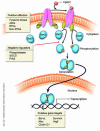Stat3 is required for the development of skin cancer
- PMID: 15343379
- PMCID: PMC514594
- DOI: 10.1172/JCI22800
Stat3 is required for the development of skin cancer
Abstract
Signal transducer and activator of transcription 3 (Stat3) is a transcription factor that is constitutively activated in a variety of human malignancies, including prostate, lung, brain, breast, and squamous cell carcinomas. Inhibition of activated Stat3 leads to decreased proliferation and apoptosis of many cancer-derived cell lines, while the introduction of a constitutively activated form of Stat3 into immortalized human breast epithelial cells and rodent fibroblasts results in cellular transformation. Collectively, these data suggest a role for Stat3 in oncogenesis. A new study from Chan et al. is the first to demonstrate a requirement for Stat3 in de novo epithelial carcinogenesis in vivo. Using the two-step model of chemically induced skin carcinogenesis, the authors demonstrated that mice deficient in Stat3 were completely resistant to skin tumor development.
Figures


Comment on
-
Disruption of Stat3 reveals a critical role in both the initiation and the promotion stages of epithelial carcinogenesis.J Clin Invest. 2004 Sep;114(5):720-8. doi: 10.1172/JCI21032. J Clin Invest. 2004. PMID: 15343391 Free PMC article.
References
-
- Darnell JE., Jr STATs and gene regulation. Science. 1997;277:1630–1635. - PubMed
-
- Bromberg J, et al. Stat3 as an oncogene. Cell. 1999;98:295–303. - PubMed
-
- Catlett-Falcone R, et al. Constitutive activation of Stat3 signaling confers resistance to apoptosis in human U266 myeloma cells. Immunity. 1999;10:105–115. - PubMed
Publication types
MeSH terms
Substances
LinkOut - more resources
Full Text Sources
Other Literature Sources
Medical
Molecular Biology Databases
Miscellaneous

